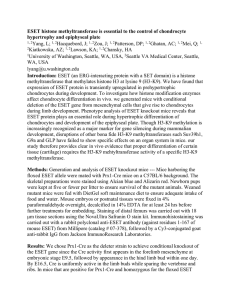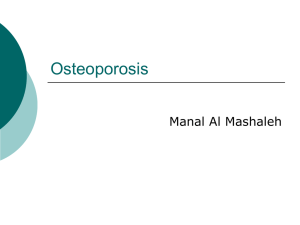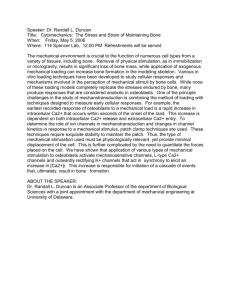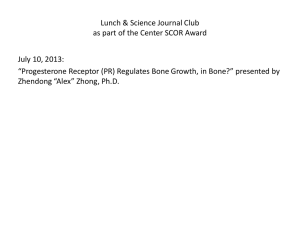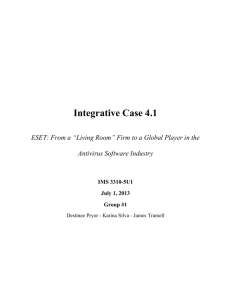The ESET histone methyltransferase is critical to osteoblast
advertisement
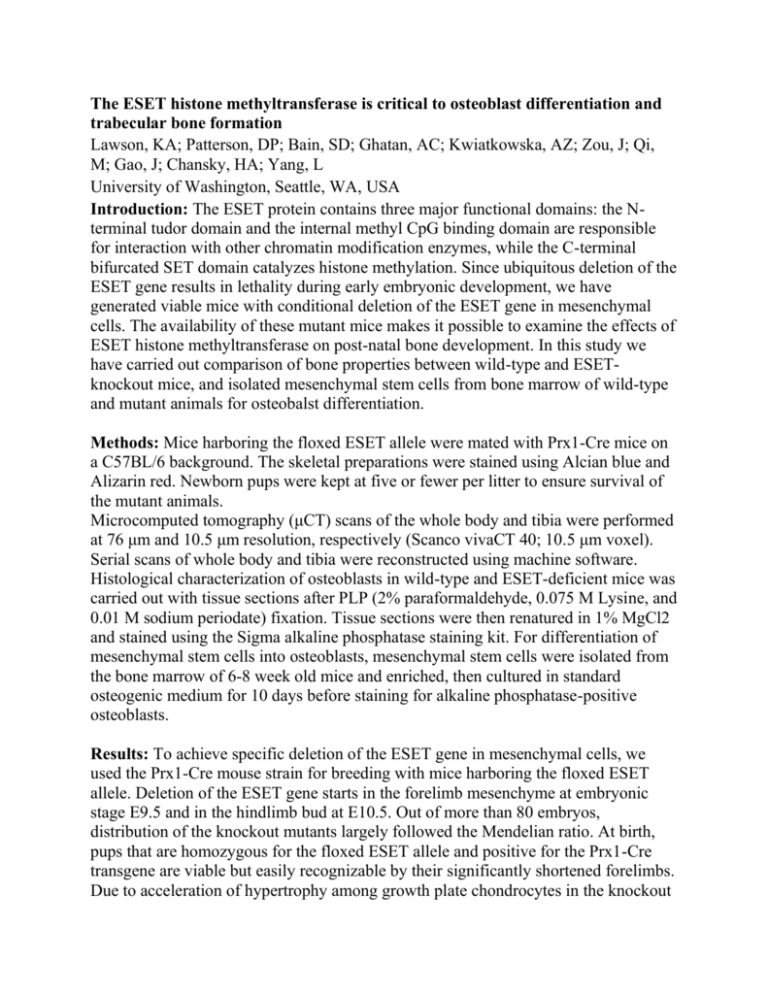
The ESET histone methyltransferase is critical to osteoblast differentiation and trabecular bone formation Lawson, KA; Patterson, DP; Bain, SD; Ghatan, AC; Kwiatkowska, AZ; Zou, J; Qi, M; Gao, J; Chansky, HA; Yang, L University of Washington, Seattle, WA, USA Introduction: The ESET protein contains three major functional domains: the Nterminal tudor domain and the internal methyl CpG binding domain are responsible for interaction with other chromatin modification enzymes, while the C-terminal bifurcated SET domain catalyzes histone methylation. Since ubiquitous deletion of the ESET gene results in lethality during early embryonic development, we have generated viable mice with conditional deletion of the ESET gene in mesenchymal cells. The availability of these mutant mice makes it possible to examine the effects of ESET histone methyltransferase on post-natal bone development. In this study we have carried out comparison of bone properties between wild-type and ESETknockout mice, and isolated mesenchymal stem cells from bone marrow of wild-type and mutant animals for osteobalst differentiation. Methods: Mice harboring the floxed ESET allele were mated with Prx1-Cre mice on a C57BL/6 background. The skeletal preparations were stained using Alcian blue and Alizarin red. Newborn pups were kept at five or fewer per litter to ensure survival of the mutant animals. Microcomputed tomography (μCT) scans of the whole body and tibia were performed at 76 μm and 10.5 μm resolution, respectively (Scanco vivaCT 40; 10.5 μm voxel). Serial scans of whole body and tibia were reconstructed using machine software. Histological characterization of osteoblasts in wild-type and ESET-deficient mice was carried out with tissue sections after PLP (2% paraformaldehyde, 0.075 M Lysine, and 0.01 M sodium periodate) fixation. Tissue sections were then renatured in 1% MgCl2 and stained using the Sigma alkaline phosphatase staining kit. For differentiation of mesenchymal stem cells into osteoblasts, mesenchymal stem cells were isolated from the bone marrow of 6-8 week old mice and enriched, then cultured in standard osteogenic medium for 10 days before staining for alkaline phosphatase-positive osteoblasts. Results: To achieve specific deletion of the ESET gene in mesenchymal cells, we used the Prx1-Cre mouse strain for breeding with mice harboring the floxed ESET allele. Deletion of the ESET gene starts in the forelimb mesenchyme at embryonic stage E9.5 and in the hindlimb bud at E10.5. Out of more than 80 embryos, distribution of the knockout mutants largely followed the Mendelian ratio. At birth, pups that are homozygous for the floxed ESET allele and positive for the Prx1-Cre transgene are viable but easily recognizable by their significantly shortened forelimbs. Due to acceleration of hypertrophy among growth plate chondrocytes in the knockout animals, there were no growth plate chondrocytes left behind at postnatal day 14 to form physis(epiphyseal plate) at the end of any long bone. Since physis is the skeletal element responsible for long bone growth, all four limbs of ESET knockout mice are therefore very short and these animals had difficulty with locomotion. As a result, ESET knockout mice had to be fed with DietGel soft maintenance diet to ensure adequate intake of food and water. To investigate the bone properties of ESET knockout mice, age- and sex-matched wild-type and ESET knockout mice were sacrificed for microcomputed tomography (μCT) imaging 6-weeks after birth. As shown in Fig. 1, the tibia of wild-type animal is significantly longer than that of the knockout mutant, and that the physis is clearly absent from the knockout animal. Another prominant feature of the knockout mice is the lack of trabecular bone. To investigate what caused such a decrease in trabecular bone volume, we prepared 10 μm sections of proximal tibia from wild-type and knockout mice. Histological staining for alkaline phosphatase-positive osteoblasts again revealed the presence of physis in the wild-type animal and an absence of physis in the mutant. In addition, alkaline phosphatase activity was significantly stronger in the wild-type tibia and more cells exhibited positive staining than in the knockout counterpart. Since osteoblasts are derived from mesenchymal stem cells, we speculate that ESET knockout in mesenchymal stem cells may have impaired the ability of these cells to differentiate into osteoblasts. To test this hypothesis, we isolated mesenchymal stem cells from the bone marrow of either wild-type or knockout animals, then cultured equal number of enriched mesenchymal cells in osteogenic medium to force differentiation into osteoblasts for 10 days. When stained for alkaline phosphatase activity, mesenchymal stem cells from wild-type bone marrow efficiently grew to become osteoblasts, whereas very few mesenchymal stem cells from the ESET knockout bone marrow were able to differentiate along the osteoblast lineage. Discussion: In this study, we have demonstrated that the ESET histone methyltransferase is critical to trabecular bone formation while mesenchymal deletion of the ESET gene led to near complete absence of trabeculae in adult animals. Since osteoclastogenesis is not affected by ESET knockout in mesenchymal cells, impairment of trabecular bone appears to be mainly caused by significantly fewer and less active osteoblasts in the bone marrow of ESET knockout mice, and this trabecular bone defect in turn has been traced back to the inability of ESET-null mesenchymal stem cells to differentiate into osteoblasts. How could ESET protein exert such a drastic effect on the differentiation of mesenchymal stem cells along the osteogenic lineage? We have found evidence that ESET interacts with Runx2 and represses Runx2 target genes. Since Runx2 can function both as a transcriptional activator and repressor, it could be explained that recruitment of ESET to Runx2 target genes may be necessary for their repression in mesenchymal cells in order for osteogenic differentiation to take place. In fact, mammalian development is an intrinsically epigenetic process in which a zygote generates hundreds of different cell types with unique epigenetic landscape. ESET histone methyltransferase, with its in vivo functions described here, may indeed represent an irreplaceable epigeneic enzyme that writes methylation of H3-K9 as the critical 'histone code' for osteogenic differnetiation. Significance: We have identified a histone methyltransferase as a critical regulator of osteoblast differentiaiton and trabecular bone formation, thus gaining new insight into skeletal development and disease process. Requirement for ESET protein in trabecular bone formation and osteoblast differentiation from mesenchymal stem cells. a, ESET protein domains and genomic structure. Note that exons 15 & 16 are flanked by two loxP sites. b-c, proximal tibia from 6-week old wild-type and knockout mice were analyzed by micro-CT scanning to show differences in trabecular bones. d-e, sagittal sections of proximal tibia from wild-type and knockout mice were stained for alkaline phosphatase activity to identify osteoblasts. f-g, mesenchymal stem cells were isolated from the bone marrows of 8week old wild-type and knockout mice. The cells were cultured for 14 days in osteogenic medium, then stained for alkaline phosphatase activity to measure osteoblasts. ORS 2013 Annual Meeting Poster No: 0636
